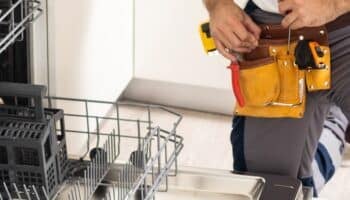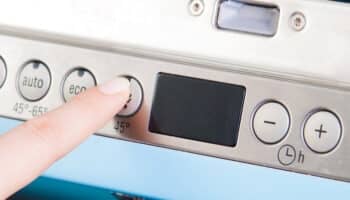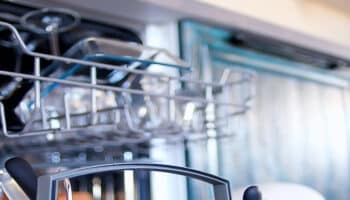We've independently reviewed this article to make sure it's as accurate as we can make it.
To find out more about our article creation and review process, check out our editorial guidelines.
Is there water pooling in the bottom of your dishwasher?
It’s actually quite a common problem – so don’t worry. In this article, you’ll learn what’s causing it and I’ll walk you through how to fix it (without paying a contractor hundreds of dollars!).
If your dishwasher keeps leaving water in the bottom, chances are food and debris are clogging it. To unclog your dishwasher pieces, you’ll need to clean out your garbage disposal, check your filter and drain house, and look at the drain pump and air gap.
So before you pick up the phone and call a plumber, keep reading to learn more about how to solve your dishwasher’s drainage problems.
Why trust us? This article was written by Craig Anderson and James Blackford.
Craig has helped thousands of other homeowners repair their appliances since 2016.
James is one of our resident appliance experts, with over 16 years of experience. He currently works as a Master Technician for SquareTrade, and runs his own appliance repair business.
How Do You Get Rid Of Standing Water In Your Dishwasher?
You wouldn’t believe how many people I’ve seen struggling with a dishwasher that has water in the bottom.
In my experience, most dishwasher standing water problems are due to clogged equipment. Don’t worry, though – In this section you’ll learn how to solve the issue.
Before trying any of the fixes mentioned in this article, please disconnect your dishwasher to prevent electrical hazards.
#1 Clean Out The Garbage Disposal
If there’s always water at the bottom of your dishwasher, the first thing I recommend doing is cleaning the garbage disposal.
You might be thinking, “What the heck does a garbage disposal have to do with my dishwasher?”
Well, most dishwashers don’t have a dedicated drainage line. Instead, they share the drain with the garbage disposal in the sink. They actually shoot all the greywater through the garbage disposal pipe to the outer pipes.
That’s why you might hear some water gurgling sounds coming through your dishwasher.
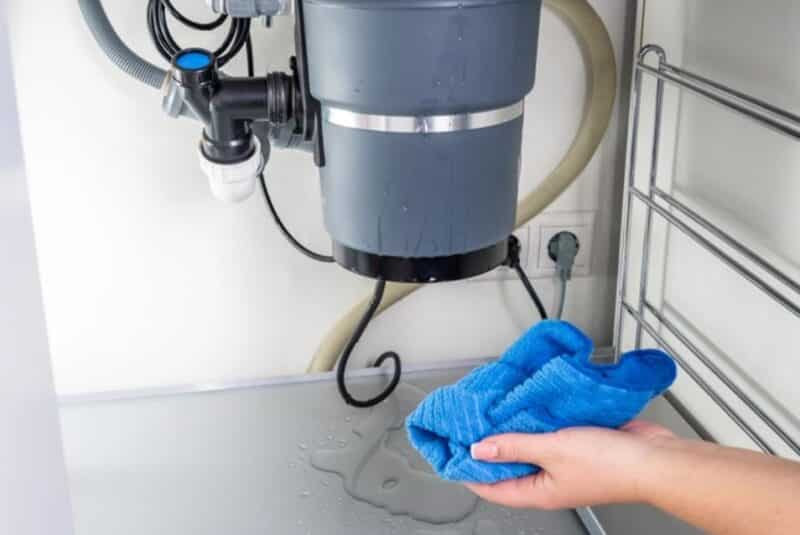
Turn on your disposal while running some hot water down the drain to see if that helps unclog the pipes.
Then, run another dishwasher cycle to see if the water has drained.
If you’ve recently installed a new garbage disposal and connected the drain line from your dishwasher to it, you need to make sure that you’ve removed the small plastic plug from the disposal nipple, which is the part where the dishwasher line connects.
This plug can prevent water from flowing through the drain line, causing it to accumulate at the bottom of your dishwasher. Removing the plug will open the connection between your dishwasher and garbage disposal and allow water to flow.
#2 Check Your Filter
In my experience, water can be left at the bottom of your dishwasher if you haven’t cleaned the filter in a while.
You see, the filter catches food debris to keep it from getting back into your dishes. However, if it gets clogged, water won’t have a place to drain, so it will sit at the bottom of your dishwasher.
I recommend pulling out your filter and cleaning it with hot soapy water. You can also use a stiff nylon or wire brush to remove any stubborn debris.
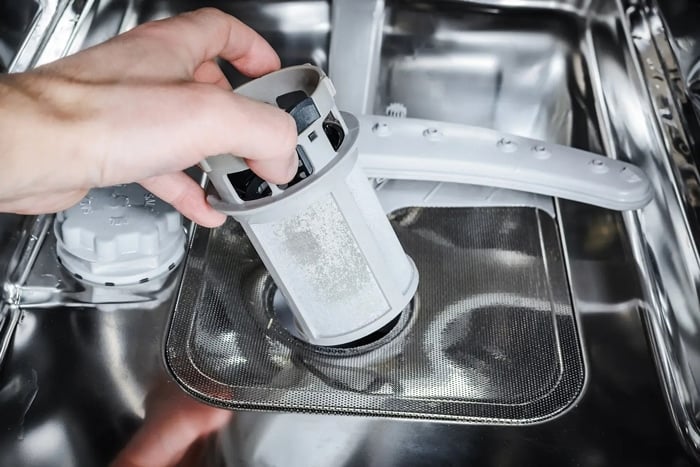
#3 Check Your Drain Hose
If there’s still water in the bottom of your dishwasher when not in use, then you’ll need to check the drain hose.
Just like with your filter, the drain hose can get clogged up with any food or debris that gathers over time.
In my experience, the simplest way to check your dishwasher’s drain hose is by locating where it connects and disconnecting it from that point. Then, place a bucket underneath and activate the drain to monitor how it’s draining.
If you just get a small amount of water, you’ve likely got buildup in your drain line. The best way to unclog it is by running a snake down the drain as far as possible.
Tip: If you don’t have a snake, I recommend using an old cable line!
If you start to feel a little resistance and notice a lot of grease on there, then food debris was likely the problem causing the standing water.
Bear in mind that the drain line will smell, especially if grease is spilled up. It can also splash on you, so please be careful.
Sometimes, the hose isn’t clogged at all but is bent at a sharp angle, cutting off any way for your water to drain properly.
If the hose is damaged, I recommend replacing it with a new one.
#4 Unclog Your Drain Pump
If your dishwasher still has water in the bottom, I recommend checking the drain pump.
This component is connected to your drain hose and is responsible for pumping the dirty water from your dishwasher into your home’s pipes.
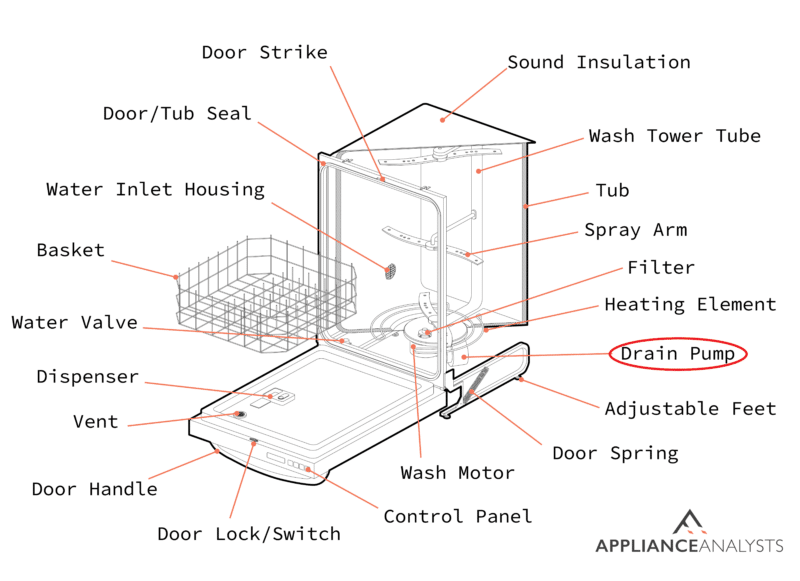
Some of the food debris from the dishwasher into your pipes can get stuck in the drain pump, preventing it from effectively removing the water from your dishwasher.
All you need to do is clean the drain pump and remove any obstructions. While you’re at it, please inspect the drain pump and replace it if you notice any signs of damage.
Don’t worry, though – Drain pumps typically cost $20 to $40.
Please wear some thicker gloves when checking the pump because you don’t know if there are sharp objects.
Just like with the other methods, when you’re done checking the pump, please run a cycle to see if the water ends up draining through your pipes.
If you want to get any replacement part – or see how much one would cost – click to enter your model number in the search bar below. Our partners at AppliancePartsPros stock almost every part with free guides on how to install them.

#5 Look at the Air Gap
If you’ve tried the fixes above, but there’s still water in the bottom of your dishwasher, I recommend checking the air gap.
Some dishwashers will have an air gap, but not all will. The air gap usually sticks out of your sink area, and the shape looks like half of a popsicle.
The air gap helps keep the dirty water from coming in contact with your clean dishes. In my experience, debris from your sink can clog up the air gap and prevent any water drainage, resulting in water at the bottom of your dishwasher.
Personally, I pick out any debris with tweezers. Just keep in mind there’s a chance you need to disassemble the air gap and then run a small snake through to unclog the area.
How To Maintain Your Dishwasher To Prevent Standing Water
There are different things you can try to prevent water from accumulating at the bottom of your dishwasher.

I recommend washing away as many food particles as possible before throwing your dishes into your dishwasher.
The less food debris that has to go through the dishwasher parts, the fewer issues and clogs you’ll have over time.
If you’ve had the same dishwasher for a long time and haven’t cleaned out the individual pieces yet, it’s time for a deep clean.
Take apart your dishwasher’s filter and spray arms and give them some love and care. Take apart the air gap and clean it thoroughly, as well as your drain pump.
In my experience, soaking your dishwasher’s components in vinegar overnight can help break down any stubborn stains and debris.
Make sure to check out our dishwasher maintenance & care guide for more helpful tips!
Conclusion
There’s nothing more annoying than having water in the bottom of your dishwasher, even when it’s not in use. Luckily, now that we’ve covered everything, you’ll be able to get rid of the standing water.
Remember to clean your garbage disposal and dishwasher’s filter. It’s also important to check the drain line, hose, and pump to prevent standing water from reappearing.
Thanks for reading. If you found this article helpful, please check out our other related guides below.
Good luck!





